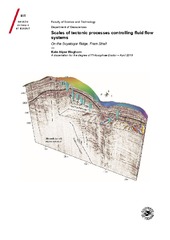| dc.contributor.advisor | Bünz, Stefan | |
| dc.contributor.author | Waghorn, Kate Alyse | |
| dc.date.accessioned | 2019-07-31T08:30:50Z | |
| dc.date.available | 2019-07-31T08:30:50Z | |
| dc.date.issued | 2019-06-13 | |
| dc.description.abstract | The Svyatogor Ridge, located in the Fram strait, is a site hosting a fluid flow system. The Svyatogor Ridge is part of the inside corner high at the Knipovich Ridge-Molloy Transform fault intersection. The Knipovich Ridge is an ultra-slow, melt-poor spreading ridge with approximately 8 mm/yr spreading rate. At this northernmost segment of the Knipovich Ridge, spreading is predominantly accommodated by crustal scale detachment faults. While fluid flow systems are not atypical on mid-ocean ridge flanks, the geothermal gradients are generally too warm and sediment cover too underdeveloped for generation and formation of gas hydrates, despite methane release from hydrothermal vent systems being well documented. In this study area, the convergence of a well developed sedimentary cover atop partially serpentinized ultra-mafic mantle material and a comparatively cool geothermal gradient entails a gas hydrate system in an unusual location. This thesis characterises a potential abiotic methane hydrate accumulation site in terms of structure, sedimentology, evolution and fluid flow systems. We find a link between crustal faulting in serpentinized mantle material and gas hydrate/free gas accumulations leading to the conclusion that abiotic methane is likely contributing to the gas hydrate system here. The stress regime has been an important factor on the Svyatogor Ridge for controlling fluid flow through geological time and into the future. High-resolution 3D P-Cable seismic data was integral for identifying fault and fracture networks, which drive fluid migration as normal extensional faulting becomes sub-optimally positioned for fluid migration. | en_US |
| dc.description.doctoraltype | ph.d. | en_US |
| dc.description.popularabstract | The Svyatogor Ridge is a subsea site on the flank of a divergent plate boundary where a gas hydrate system is studied. This system is unusual because, typically, on mid-ocean ridge flanks hydrothermal systems are common rather than gas hydrate systems. Methane generated in the deep crust through interactions between rock, gases and water (abiotic methane) is also relatively uncommon to find in gas hydrate systems however the Svyatogor Ridge may be one of the first documented gas hydrate systems sustained by abiotic methane. Faults, including plate boundary faults, are important pathways for methane moving through the subsurface and this thesis summarizes the relationships between scales of faults – from plate boundary faults to very small faults-, fluid migration and potential abiotic methane in this study location. | en_US |
| dc.identifier.isbn | 978-82-8236-350-1 (trykt) 978-82-8236-351-8 (pdf) | |
| dc.identifier.uri | https://hdl.handle.net/10037/15813 | |
| dc.language.iso | eng | en_US |
| dc.publisher | UiT Norges arktiske universitet | en_US |
| dc.publisher | UiT The Arctic University of Norway | en_US |
| dc.relation.haspart | <p>Paper I: Waghorn, K.A., Bünz, S., Plaza-Faverola, A., Johnson, J.E. (2018). 3D Seismic investigation of a gas hydrate and fluid flow system on an active mid-ocean ridge; Svyatogor Ridge, Fram Strait. <i>Geochemistry, Geophysics, Geosystems, 19</i>(8), 2325-2341. Also available at <a href= https://doi.org/10.1029/2018GC007482> https://doi.org/10.1029/2018GC007482</a>. Accepted manuscript version available in Munin at <a href=https://hdl.handle.net/10037/13331>https://hdl.handle.net/10037/13331</a>.
<p>Paper II: Waghorn, K.A., Vadakkepuliyambatta, S., Plaza-Faverola, A., Johnson, J.E., Bünz, S. & Waage, M. Crustal processes sustain arctic abiotic gas hydrate and fluid flow systems. (Submitted manuscript).
<p>Paper III: Waghorn, K.A., Romeyn, R., Plaza-Faverola, A. & Bünz, S. Shallow gas redistribution coupled to Arctic Mid-Ocean Ridge tectonics. (Manuscript). Available in the file “thesis_entire.pdf”. | en_US |
| dc.relation.projectID | info:eu-repo/grantAgreement/RCN/SFF/223259/Norway/Centre for Arctic Gas Hydrate, Environment and Climate/CAGE/ | en_US |
| dc.rights.accessRights | openAccess | en_US |
| dc.rights.holder | Copyright 2019 The Author(s) | |
| dc.rights.uri | https://creativecommons.org/licenses/by-nc-sa/4.0 | en_US |
| dc.rights | Attribution-NonCommercial-ShareAlike 4.0 International (CC BY-NC-SA 4.0) | en_US |
| dc.subject | VDP::Mathematics and natural science: 400::Geosciences: 450::Solid earth physics: 451 | en_US |
| dc.subject | VDP::Matematikk og Naturvitenskap: 400::Geofag: 450::Faste jords fysikk: 451 | en_US |
| dc.subject | VDP::Mathematics and natural science: 400::Geosciences: 450::Tectonics: 463 | en_US |
| dc.subject | VDP::Matematikk og Naturvitenskap: 400::Geofag: 450::Tektonikk: 463 | en_US |
| dc.subject | VDP::Mathematics and natural science: 400::Geosciences: 450::Marine geology: 466 | en_US |
| dc.subject | VDP::Matematikk og Naturvitenskap: 400::Geofag: 450::Marin geologi: 466 | en_US |
| dc.title | Scales of tectonic processes controlling fluid flow systems on the Svyatogor Ridge, Fram Strait | en_US |
| dc.type | Doctoral thesis | en_US |
| dc.type | Doktorgradsavhandling | en_US |


 English
English norsk
norsk

